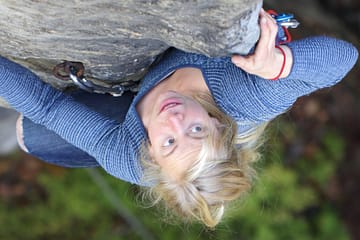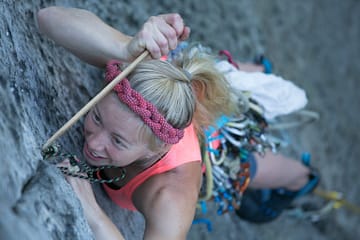Though I have spent most of the last six years in the Old World, I had never actually climbed in Europe… until this spring.
By chance, I started copyediting eMontana’s English language articles, a Czech climbing and adventure oriented online magazine. The editor in chief, Standa, invited me to come experience some of the sandstone climbing along the Elbe River in the Czech Republic and in Germany. After visiting friends in Berlin, it made sense to head south. I’d been to the region before and remembered catching glimpses of stunning cliff lines and towers as I pedaled past on my way north.
Wide eyes and a nervous laugh were the usual response to “I’m going to climb in Elbsandsteingebirge”. I’d heard about the climbing on the German side, in Saxony, before. It’s famous for being sparsely bolted and not allowing climbers to use chalk, cams, or other types of metal protection. It’s known for being some kind of dangerous. The month before I went, I corrected an article about injuries sustained by climbers. I told my friends, “It’s okay, I’ll be with a local and probably will just top rope stuff.”
I arranged to meet my local contact, Standa Mitac, at the train station on a Wednesday morning. It was easy to find him, like he said in his last email, “I’ll be the guy who looks like a climber”. We went straight to the right bank of Labak. The Elbe Valley on the Czech side has some 10,000 routes. Unlike the German side, chalk is permitted and bolts are a little bit closer together, sometimes.
“Tell me honestly, what grade do you feel very confident onsighting?”
Kruh za kruhem: Bolt after bolt
The first route I got on was an VIIIb, local grade, which is something like 6b+ or 5.11a.
Eighty meters. Yes! 80m of pure stone, 14 bolts. A sea of jugs leads to spaced crimp rails. Iron bands through black rock followed by zones of small pockets, one after another like rain on sand. The last 20m was a friction slab and I suddenly didn’t know what to do. Not only was the rope so absurdly heavy, but the rock had curving waves and no holds.
The first time I ever climbed with the full awareness that “this is rock climbing” was on a J-Tree 5.8 slab. ‘What to do’ on that style of rock seemed so obvious to me at the time… fast forward 17 years and all I can think about is how I might fart and throw my balance off. I made it to the anchor – which was a single, giant ring, and rappelled twice to return the ground. Rappelling was intimidating, not scary per say, but just another thing that I haven’t been doing so often in the last few years. The last decade. How wonderful to climb so many meters! The difference is stark: uninterrupted movement over rock as opposed to finding the easiest path up the hardest route at the upper limit of my ability. On the ground, I thought, maybe it’s time to move away from projecting for a bit.
The Myth: Onsight or Die
Everything I knew about climbing in the region before I arrived had a negative tint. I try to always have an open mind, not to make assumptions or predictions, yet the information we glean from friends, stories, eMontana magazine articles about injuries, do color our perceptions on places. I arrived with a firm jaw, trying my best to be prepared mentally for anything and everything. At the same time, I placed some blind faith in my local partner. I felt like it was a fairly safe assumption that he wouldn’t want a guest from abroad get injured on his watch.
As I moved my small body upwards over the featured sandstone, I signed a contract with a swift and steady hand. Occasionally, I’d encounter a move I couldn’t downclimb. The point of no return offers invaluable insight into the innerworkings of the mind; a mix of silence and white noise. I found an impossible place where I couldn’t be more present in my body or further removed from reality. Having made the decision, it was easy to stick to it and continue climbing.
My firm resolution to be brave and only climbing routes well within my ability kept me safe on the wall.
Logical and Illogical Fear
A half dozen meters from the top of Nautilus VIIIc (local Saxon grade), there was a small ledge. The shiny new glue-in next to the elderly, rusted bolt two moves above the ledge (I suppose others can clip from the ledge, those tall-ass men…) inspired some confidence. But, there were no more holds upwards, and no more chalk to guide the way. “Go to the right!” my belayer suggested to my relief. My nervousness set in a few minutes later, three meters up to the right and three meters up above the bolt. I felt up and touched an 1/8th of a pad crimp with my left hand. I needed my other hand to be there instead, so I carefully downclimbed two moves. I set myself up to reach up with my right. The rippled grey rock gave nothing away, my hand brushed lichen and nothing else. I lost the hold. Desperately trying to deduce its location, I pushed past my lower limit of my lockoff strength, latching on the tiny incut crimp just before my body fell away from the wall. The knowledge that I narrowly avoided taking a 30-foot swinging fall only made me more motivated, more curious about all of these other incredible lines towering above the forested banks of the Elbe River.
The Myth Transformed
Expectations and assumptions get me into trouble. Relying on someone else’s opinion of a crag, a route, someone else’s beta, hold me back and, in the worst-case scenario, can prevent me from experiencing something new and worthwhile. I won’t say that Labak is the safest place in the world to climb, but I also don’t think it’s absolutely absurd. The bolting seems logical, the rock solid. The setting is serene and the climbing seems endless. One myth is replaced with another: I’m pretty sure fairies live in those towers, which is why locals climb with tiny wooden swords attached to their harnesses. I can’t wait to go back.



1 Comment
Kelly · June 11, 2018 at 8:34 am
I cannot think of a sport I’m less suited to, heights terrify me and I have no upper body strength, yet your descriptions make it seem more appealing than I’d have thought. It’s clear that doing this well requires focus, a sort of mindfulness and presence in the moment that’s hard to find in such busy lives. It’s for that very same reason I play roller derby, challenges that seem to stretch our boundaries of doable are so invigorating.
I just adored the little point about fairies at the end too, wasn’t expecting that and it was made all the more delightful because of it.